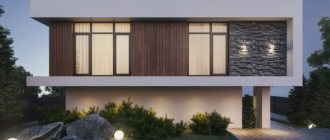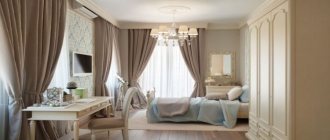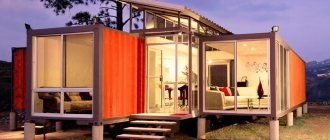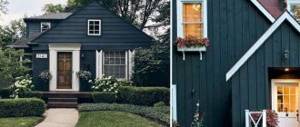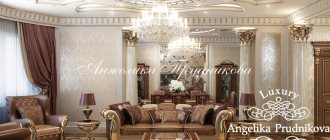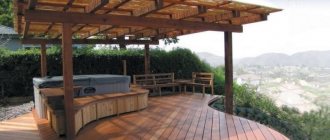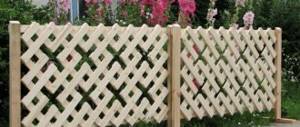What types of fences are there for a private home?
- Several important aspects come into play here, and first of all, the location of the property, then, based on financial capabilities, the material for the fence, its functional purpose, etc. are determined.
- In order to decide which material will be the optimal solution, you must first understand what task the fence should perform: just a fence or a barrier for an uninvited guest, or someone else's envious glance.
Diversity
- Then it will become clear not only which initial raw material will be the best, but also such parameters as the required strength of the material, whether a continuous fence or with gaps is required, etc.
- Of course, the dimensions related to both the site itself and the private house are important, so that they look proportionate in relation to each other. It is necessary to pay attention to the fact that the style in which the fence is made matches the style of the house that it will enclose, and is combined in color and other parameters.
- And, of course, you need to take into account the landscape on which your property is located, and such a very significant detail as the amount of finance, which directly determines whether you can make your dream come true or whether you are content with what you can afford.
The main options that are used today are:
- Stone fences. They are most appropriate if the facade of the building is also finished with stone or its imitation (in whole or in part). This type of fence looks very respectable, is quite strong and durable.
Massively
- Brick fences for a private house. This type of fencing is much cheaper, and it looks quite solid, especially if you successfully combine brick with metal or the same stone, “guess” the color.
Made of brick
- Concrete masonry. A fairly affordable option, it is in high demand due to the possibility of their quick installation, but the main drawback is their relative fragility.
Concrete
- A metal fence can be made using either corrugated sheets or forged products. In the first case, you get a fairly durable fence that is not susceptible to environmental conditions. However, it does not withstand impacts well and is quite capable of becoming dented. The second option creates a feeling of spaciousness, visually increasing the area of the site, but such fences look relatively simple. Such fences are unlikely to be suitable for those who do not want to “be visible” to prying eyes. Therefore, metal fences, especially forged ones, are often combined with another material or with a green fence.
Dominant look
- Wooden fences for a private home are no longer what they once were and were a classic picket fence, subject to all weather misfortunes that reduce its service life. Therefore, we are not talking about the durability of such fences, but if they are successfully combined with the architectural structures of the fenced area, this is quite acceptable.
Wood
- A slate fence looks simple and rather unpresentable due to its gray color. But as an option for a quiet area, without heavy traffic and pedestrians, it is quite appropriate due to its relative cheapness. Such a fence cannot be called durable; it is quite fragile, but the small costs invested in the purchase of such a fence are completely justified.
Slate
If you are choosing fencing for your home, consult with your family. But also consult with professionals. Keep in mind that most often the fence is installed for decades, so it must be durable and pleasing to the eye.
Concrete fences
A fence made of concrete blocks is quickly and easily installed; the texture and color of the fence can be selected individually by the customer. The fence turns out smooth, neat and beautiful. Dismantling the blocks is also very simple. Concrete blocks combine well with forging elements.
Concrete fence.
Concrete fence (made of slabs).
DIY fences for a private house
- You should start by familiarizing yourself with the regulatory documents regarding this, in order to correctly maintain the distance both between neighboring houses and to the roadway, and so that your fence does not “fall out” of the entire row.
- The standards provide for a distance from the fence to the house - 3 m or more, to non-residential premises - at least 4 m. Trees should not “approach” closer to the fence than 2 m, and shrubs should not be closer than a meter. The height of the fence can be up to 2.5-3 m, depending on the height of the house itself. Slightly different requirements for a fence for a private house separating neighbors - it should not exceed one and a half meters, and the neighboring yard should be partially visible.
- If you have the skills, you can build a fence yourself from any material: be it plastic or wood, the usual chain-link mesh, metal or concrete, or even lay it out with good old brick. The result of combining several of the above materials is interesting: say, wood with stone or brick.
Combination
- And, of course, any fence will be decorated with a hedge (and in some cases, by the way, they limit the fencing of their territory to it).
- Each of the above materials has its own advantages and disadvantages: the most durable and solid fence is made of stone, the least obstacle to overcoming the fence is wood or chain-link mesh. Therefore, in each specific case, the golden principle should be taken into account, combining the concepts of functionality, quality and price.
Plastic
Plastic fencing is not suitable for fencing a site from the street, but it is successfully used for zoning an area, as well as for establishing boundaries between neighboring sites.
- Plastic fences make the site more aesthetically pleasing.
- Functional zones are successfully demarcated. For example, flower beds, playgrounds, recreation areas.
- Plastic is resistant to temperature changes, is not afraid of moisture, and does not rot.
- Over time, plastic fencing will not change color.
- There are many design options from which you can choose the most suitable type of fence.
- The sizes of the plastic sections provide even more choice for creativity.
- Insufficient resistance to mechanical damage.
- It is advisable to use only inside the site.
- The service life usually does not exceed 12-15 years.
Read also: Fried red sea bass recipes with photos
We have analyzed the most popular materials for constructing fences. Which one is better to choose and what the fence can be made from is decided on an individual basis, taking into account many related factors. Consider the purpose of the fence, the location of the site (house or cottage), your financial capabilities, and possible labor costs.
A fence for a private home is considered an important element in arranging your own property. It not only limits the area and protects it from uninvited guests, but also creates the first impression of the owners.
Fences can have different designs and be made of different materials, but in any case, their construction should be approached responsibly, taking into account reliability, local traditions and existing standards.
Inexpensive fence for a private home
- Now, with a huge selection of materials, it is quite possible to find an option that is acceptable both in price and quality. Of course, a budget fence for a private home also needs to be thought out regarding what purpose it serves and what its main function is: preventing free passage through your territory or decorative.
- For example, it is quite acceptable to fence a small area with a chain-link mesh, a larger area with a picket fence , and if you need to inexpensively fence a large area, then corrugated sheeting .
- The most expensive is a metal fence made of Euro picket fence, which is durable, resistant to gusts of wind, and at the same time looks quite aesthetically pleasing on the site. The practicality of such a fence allows you to even make it the base surface for a street lighting scheme. Among the disadvantages are the relatively lengthy installation and the attractiveness of a metal fence for “metal workers” who hand over stolen metal for pennies to scrap collection points.
Fence
- A fence made of polycarbonate , which is usually combined with another material, will cost less It is quite durable (if all technologies are followed and a UV layer is applied) and easy to install. Corrugated sheeting can also be chosen inexpensively, and it is better to use this material for fencing a small area, since it must be installed on a foundation, and this is an additional expense. This is a very popular budget option.
Polycarbonate
- Plastic is also affordable for most, it is durable and easy to assemble, and looks quite attractive. In addition, it does not require special care. Well known to everyone, familiar and quite affordable - a chain-link mesh, which even a novice owner can install. But it also has disadvantages: it is not particularly durable, it also opens up a wide view of your territory to prying eyes, and it also quickly loses its appearance under the influence of external factors.
- A wooden fence is the most budget-friendly option for fencing, especially since, with desire and skill, you can create almost a masterpiece out of it. Among the advantages of such fencing are its undoubted environmental friendliness and easy installation, but its disadvantages include fragility and a high degree of susceptibility to external factors.
Budget and environmentally friendly
- One of its varieties is a palisade, which is also quick and easy to install. And finally, planting living trees or shrubs that are woven into a hedge - if you don’t use outlandish overseas plants for this, of course, is quite affordable for people with average incomes. One more piece of advice: if your fence has lost its former appearance, do not rush to change it. Try updating it with a photo grid.
What types of fences are there for a home?
Modern building materials make it possible to realize the most fantastic and original ideas when constructing fences for private houses. Fences are divided into different types according to their design and materials used. There are several varieties:
Based on materials:
- Wooden fences - planks, picket fences, picket fences, panel fences, veneered fences, wattle fence.
- Fences made of brick or block (cinder blocks, foam blocks) masonry.
- Stone fences – artificial or natural stone.
- Concrete fences - monolithic by pouring concrete or from reinforced concrete panels.
- Metal fences - forged, mesh, lattice, made of corrugated sheets, metal sheets, profile pipes.
- Fencing using slate sheets.
- Plastic fences - panels, siding, block house. Polycarbonate fences stand out in particular.
- Glass fencing.
- Hedge.
- Combined options - a different combination of these varieties is used.
Based on their design, there are monolithic (stationary, non-dismountable), prefabricated (collapsible) and mobile (temporary, portable) structures.
According to installation features:
- production by masonry;
- welded structures;
- with a foundation (strip or columnar) or on the ground;
- by driving piles;
- planting;
- frame type.
According to the design decision - forged, openwork, with decorative inserts, special design of the upper part, original columns, etc.
When choosing the type of fencing, first of all you should pay attention to reliability and durability. Their strength must withstand strong gusts of wind and snow loads, as well as mechanical stress. The material must be resistant to any climatic influences (water, solar ultraviolet radiation, high temperatures in summer, temperature changes, frost, etc.).
Almost all fences consist of the following basic elements - a foundation (base), support pillars and spans between supports. Even when constructing monolithic walls, this principle of structural formation is preserved. In prefabricated systems, load-bearing horizontal elements are attached between the pillars, onto which a covering made of different materials is mounted.
Features of wooden structures
The most common material for making fences is lumber (wood) . Wood has such positive qualities as
- ease of processing and installation;
- variety of forms;
- low cost;
- natural appearance and environmental friendliness.
Such a fence around a wooden house, against the backdrop of a garden and flowering shrubs, looks especially harmonious.
The main disadvantage is the tendency to rot under the influence of moisture and cracking during operation, reduced mechanical resistance to shock, the possibility of pests and fungi, and flammability. Wooden parts must be impregnated with an antiseptic composition, and it is advisable to apply a protective coating (paint, enamel, varnish) on top.
The following main types of wooden structures can be distinguished.
plank fence
Support posts are made of logs or timber . Horizontal beams are mounted between them, onto which boards are then fixed. They can be installed with a gap (translucent type) or closely (solid fence), without gaps.
Sometimes the “overlap” method is used, when the boards overlap each other. This design is highly decorative. One of the common options is a picket fence . In this case, the upper part of the board ends with a pointed triangle.
Paving stones
A fencing is made from timber in a similar way to a plank fence, but this design is more massive and reliable. A blind fence is mounted from profiled timber.
Fence
In this design, wooden slats (pickets) up to 10 cm wide are fixed to horizontal load-bearing elements with a gap.
Such a fence can be of different heights. The most elegant look is the European picket fence , which is of high quality.
Slatted fencing
Transparent type fences can be made in the form of a lattice made of wooden slats. In this design, the span is made in the form of a rectangular frame made of timber, and a slatted mesh is formed inside it, and the slats can be positioned horizontally, vertically, or diagonally.
Panel structure
The main difference of such a fence is that the entire span is assembled in the form of a shield from boards, plywood, chipboard, and then attached to support posts.
A massive fence can be assembled according to the fortress type - from logs in the shape of a log house. Such a fence will help in areas where large, wild animals live.
Wooden fencing has low durability - the average service life is 16-17 years. Painting and varnishing wood helps to improve it somewhat, but repairs must be carried out in a timely manner and in full.
Stone fences
Natural stone allows you to build a beautiful and impressive, monolithic fence. It is characterized by high strength, inaccessibility and increased durability (at least 50 years).
Read also: How to make a grape juicer with your own hands
An important advantage is that stone walls do not require special care. This design will fit into different styles of landscape design. Disadvantages include the high cost and difficulty of doing it yourself.
To build a fence, cobblestones of different sizes, rubble, limestone, and sandstone are most often used. As a base, a strip foundation is made along the entire perimeter.
The supporting stone columns have an increased thickness compared to the masonry spans. For reliability, it is better to reinforce them with steel vertical rods.
You can reduce the cost of fencing by using artificial stone, which is much cheaper. It is sold in the form of blocks, and therefore it is easier to make masonry from it.
Brickwork
Brick fences are very popular among owners of rich houses who do not strive to save money. When using high-quality brick, there is no point in covering the wall with something on top - it looks great and will retain its appearance for a long time. Compared to a stone fence, a brick structure is less resistant to impact loads and during operation is subject to aging under the influence of atmospheric conditions.
Cheaper and lower quality bricks may begin to crumble after 5-6 years. Plaster helps increase its service life . On top of this layer you can paint it any color or whiten it.
By analogy with stone, a brick fence includes massive support pillars with reinforcement and less thick spans. The span can be laid with a thickness of 0.5 - 1 brick. Sometimes it is made with gaps or with protrusions of individual bricks in a certain order, which provides an original appearance.
Construction of concrete fences
Concrete fences can be erected by pouring ( monolithic structure ) or from reinforced concrete slabs ( collapsible structure ). In the first case, support pillars are first made of concrete with reinforcing linkage in the longitudinal, transverse and vertical directions. Then the formwork is installed and the spans are poured in the form of concrete walls 10-20 cm thick.
The surface of the spans can be decorated with marble chips or decorative colored plaster. A simpler option involves painting or whitewashing. At the top of the concrete span, various elements can be formed - an arch, a battlement, a tent , etc.
The fastest option for erecting a fence is installing reinforced concrete slabs . This option will provide high strength to the structure, but requires the use of lifting mechanisms. To install the fence, it is better to use special reinforced concrete pillars, which have grooves on both sides for installing slabs. In this case, welding or other methods of attaching the span to the support pillars will not be required.
Metal constructions
Metal fences have high strength and durability. Quite attractive structures with a respectable appearance are built from various metal elements. They can have the following varieties:
- Fence made of corrugated board . A chic, solid fence can be made from corrugated sheets with a protective plastic coating. This material is not subject to corrosion and will last for many years. It is available in different color shades. An economy class fence can be built from a standard profiled sheet (without coating). It looks much more modest and requires subsequent painting, but is much cheaper.
- Mesh structures . The following common options can be distinguished: a span in the form of sections made of a profile pipe covered with a metal mesh, and a fence made of chain-link mesh.
- Metal picket fence . This design has become very popular recently. This is how a semi-closed fence is erected. Neatness and aesthetic appearance can be achieved when using products of the “Euro picket fence” category.
- Forged fences . These transparent fences are expensive, but look impressive. In their production, purchased forged parts or custom-made elements are used.
- Welded or openwork structures . Metal strips, rods, rods are given various shapes, and by welding them together it is possible to reproduce a real work of art on the fence.
Metal elements require reliable protection against corrosion. For this purpose, paints or special primers are used.
Slate fences
Slate sheets installed vertically provide the required fence span height.
An important advantage of this design is speed and ease of installation. Disadvantage: low impact strength . Slate can be mounted on wooden supporting beams, fixed horizontally between supports.
Combined designs
Quite often, various combinations of different materials are used in the manufacture of fences. The most common combined structure is concrete or brick support pillars, and the spans are made of any other material.
More complex combinations can be used in the manufacture of spans. The option looks impressive when the bottom of the span is made using stone or brick masonry with the formation of a semicircular recess. A metal, openwork plexus is mounted in such an opening.
Plastic fences
Plastic is increasingly being used in building structures and fences are no exception. Plastic fences are distinguished by their resistance to weathering, lightness, ease of installation, and low cost. Disadvantages - low resistance to scratching, rapid contamination, insufficient decorative effect.
is most widespread in the form of slabs, sheets and panels . With their help, the following types of fences are erected:
- blank sheets;
- fence;
- wattle fence;
- from narrow panels similar to a board;
- mesh type.
The plastic fence made of polycarbonate stands out especially. This modern material is an analogue of silicate glass, but has flexibility and impact resistance. With its help you can build transparent fences.
Combined structures look original - the bottom is in the form of stone or brickwork, and the top is made of transparent or tinted polycarbonate.
Using a hedge
A hedge-like fence is formed by planting shrubs or climbing plants in a row. By branching, they create an original wall from their stems and leaves. Deciduous, evergreen or flowering plants are used. The following varieties are distinguished by height: low (no more than 1 m), medium height (1.1-1.6 m) and high (above 1.6 m) hedges.
The advantage of a plant fence is unity with nature, floral aroma, moisture retention . Among the disadvantages, the following factors should be highlighted: the need for watering and other plant care, the accumulation of harmful insects and rodents, and delayed snow melting.
Glass structures
Fans of original design are attracted by the use of high-strength glass in the construction of fences. This material visually expands the space and provides many design options.
Currently, unbreakable glass sheets are offered for this purpose - transparent, frosted and color-tinted. With numerous design advantages, the most important drawback should be noted - high cost.
The area behind the fence of a private house
- We are talking about a piece of land near the house on which farming is carried out and the house itself is maintained. It is the border of this territory that can become the site for installing a fence, delimiting the property of the owner of the site and the municipal property (located on the other side of the fence). By the way, there may be several owners.
- If the calculation of the local area for apartment buildings is carried out according to a formula, then this option is not suitable for the private sector. To measure a site, it is necessary to draw up a plan, marking the boundaries of the territory on it and plotting absolutely all the buildings located on the site. Having settled the issue with the neighbors and made sure that there are no disagreements regarding the rights to the land, the owner can register ownership of it by placing the plot on the cadastral register.
Design solution
- You can also register a lease for the territory behind the fence by contacting the local government, where they will also determine the rent depending on the area indicated in the cadastral documents. Having registered the territory behind the fence of a private house as property, the owner is obliged to keep it clean, just like the area adjacent to the street (usually about one and a half meters).
Brick fences for a private house
Nowadays they are especially in fashion, they are convenient because you can choose the appropriate height and thickness of the fence yourself, such fences are practical and reliable, not to mention the fact that many can lay the brickwork themselves, without resorting to the services of workers.
The advantages of brick fences for a private home include:
- Reliability . This is a high-strength fence that completely hides the territory from prying eyes and, at the required height, from encroachments on your property.
- Durability - brickwork is resistant to temperature changes, rain, snow and other climatic factors.
- A respectable appearance, especially if you complement the fence with architectural elements in the form of arches or columns.
- Does not require painting or other maintenance.
- Transforms the appearance of the entire territory, being a design part of the landscape.
Creates a wonderful appearance
. Among the disadvantages:
- The relative high cost of both the brick itself and its installation.
- Used brick (if you made a fence out of it to save money) is less durable.
- Additional need for a foundation , which entails additional costs.
- The fence can be made of facing bricks, which are used for decorative masonry, giving the opportunity to have different color schemes and complement it with wood.
- You can decorate with crushed bricks, which will make the structure lighter and more elegant. Rough ceramic bricks come in different shades, which makes it possible to create your own color scheme.
- As for the usual sand-lime bricks, they are inferior in appearance to other types, but are the most reliable in operation. The clinker brick that is fashionable today is quite durable, without voids, but also quite expensive.
- Hyper-pressed brick is resistant to external natural influences, is available in different colors and can be either chipped or smooth. And finally, fences made from Lego bricks, which are not laid out in the usual way, but are connected from separate parts and glued together using special glue, are also popular.
Brick can be successfully combined with wood, corrugated board, metal picket fence, forging, stone, as well as with each other, combining chipped or decorative types with ordinary ones.
Can be combined
Brick
Brick fencing is considered traditional. It has been used successfully for many years. Brick is a symbol of constancy and reliability, emphasizing the taste of the owners.
- Reliable fencing.
- It harmonizes with almost all building materials: stone, metal, wood, glass.
- Durability.
- Does not require repair or maintenance.
- When a brick fence is made, a powerful foundation is poured due to the significant weight of the structure.
- The cost of such a structure is considered one of the highest.
- Laying requires the involvement of qualified craftsmen.
Metal fences for a private house
- Metal fences for a private home are varied; they can be picket, mesh, or forged.
Chic decoration
- Among the advantages is reliable protection against penetration into your territory, since it is almost impossible to cut them or damage them using improvised means. If you use corrugated sheeting, no one will be able to look into your yard. The distinctive quality of metal is its durability; in addition, the surfaces of metal fences are coated with a layer that protects against problems such as corrosion or rust.
- This type of fence is easy to construct, reliable and resistant to external influences. In addition, a metal fence can be made in any color that suits your overall design solution.
- The disadvantage can be considered the rather high price, especially if it is a cast product. Nets are much cheaper. In addition, after a couple of decades, a metal fence will still need painting and additional treatment to prevent rust. Nevertheless, the popularity of such fences is great.
Brick fence
This fence is not only invisible, but also the most durable and reliable. But it costs more than others, and besides, it will require a foundation.
If the brick is not intended to be coated with a waterproof finish, you should choose a brand with the greatest possible (as far as money allows) frost resistance. Special facing bricks look most impressive.
Instead of bricks, you can use unprocessed pieces of natural stone - granite or rubble (limestone, sandstone, dolomite). This material is cheaper than brick, but it is more difficult to lay.
Wrought iron fences for a private house
- The main advantage of a forged structure is its artistic value and the ability to not only choose the pattern you like, but also invent it yourself, ordering it according to your own sketch. These are strong and durable structures, at the same time they are completely easy to use.
- A forged fence is much more resistant to corrosion and external atmospheric influences. The main thing is to remember to clean it periodically, which can be easily done using a regular garden hose. It is very presentable, and at the same time successfully resists mechanical stress and any shocks.
As you know, beauty is an expensive pleasure, so the cost of wrought iron fences is high. In addition, they are quite massive, which complicates the process of transportation and installation. Another disadvantage is the openness of such structures, which does not protect from prying eyes.
Forged Splendor
- Having decided to fence your house with a wrought-iron fence, you should decide what functional purpose it will serve, and, based on this, choose the type: either it is a simple stamping, without any artistic frills, or a fence decorated with figured elements. You can also combine these two purposes by using artistic forging only in certain parts of the fence.
- Forged fences can be combined with many materials. So, using polycarbonate, you thereby screen your territory, making it inaccessible to prying eyes, as in the case of combination with corrugated sheeting. An excellent combination of a forged fence with stone or brick , on which forged rods are installed.
Metal and wrought iron fence
Probably everyone can imagine what a wrought iron fence looks like: elegant patterns of curls and other elements, vines, rosettes and a row of peaks on top. In the same way, everyone quite clearly imagines the cost of such a fence: not everyone can afford it.
Read also: Rose Park Ferdinand Pichard description photo reviews
But along with real forging, a much cheaper analogue exists today and is actively used - stamped forging, also called cold forging.
Metal fence
For cold forging, a rod or plate is taken, and the desired shape is given to it not by hammer blows, but by bending or twisting on a special machine. When composing the fabric, the parts are connected in the simplest way - using electric welding. Thus, a wrought iron fence becomes available not only for purchase, but also for self-production.
It’s okay if you don’t have access to cold forging machines or only a few of them are available: you can buy such parts in workshops or online stores - even then they won’t cost much at all.
Did you know that forged fences can be produced using cold and hot forging? Read about this on our website.
For options for making wooden fences, see this topic. Picket fence, slab, board and other materials for the construction of wooden fences.
Fences for a private house made of corrugated sheets
- A corrugated sheet is a fairly thin metal sheet (up to 5 mm), which is stamped (which toughens the metal) . The main shades are silver metal, but you can also find various base colors, the main thing is that all the sheets are from the same batch. various sizes of corrugated sheeting on sale , so you can choose the one that suits your site without subsequent adjustment to the required size.
- A fence made of corrugated sheets for a private home
is quite easily mounted on a metal frame; the sheets are laid overlapping. The main thing is that the frame itself is leveled and has strong connections - both the reliability of the entire structure and its appearance depend on this. Such fences combine very well with other materials (brick, stone, metal).
Fencing
- If we talk about the durability of the corrugated sheet , then it is treated against corrosion caused by rain or snowfall, and is quite resistant to sub-zero temperatures. The only thing that can affect it is prolonged exposure to sunlight, which contributes to slight fading of the metal.
- The disadvantage of a fence made of corrugated sheets is its weak resistance to impact : if you hit it hard, you cannot avoid a dent, not to mention if a car accidentally drives into it. Therefore, such fences are appropriate in quiet, calm areas where there is no busy traffic.
Wooden fences for a private house
- The most familiar fences to our eyes, familiar from childhood. Today, of course, they look different – stylish and modern. And if such a fence is combined with the buildings that exist on the site, this is an excellent solution. To facilitate the installation of fencing, today sections have been developed that are completely ready for use, which only need to be assembled into a single structure, and this is quite easy to do yourself.
- For those who dream of an individual project, you can come up with a sketch , which the craftsmen will carry out in accordance with your wishes.
- Wooden fencing serves more of a decorative function, since it is not particularly strong and is not able to withstand heavy loads. It is quite simple to install, incl. and yourself, you just need to take care of a reliable foundation and a solid frame. With proper regular care, such a fence will last about 20 years, and initially high-quality raw materials and the correct protective coating are important.
- And one more thing: wooden structure in your yard (bench, table, gazebo) can perfectly harmonize with a wooden fence for the private sector if they are designed in a similar style.
- This type of fence gives the facade a zest and uniqueness; it is ideal if there is a gazebo, benches or other buildings in the yard that continue the appearance of the fence in style.
Made of wood
With green design
Design
Fence design for a private house
It is unnecessary to say that the fence has now become part of the overall design of the yard. Therefore, depending on the purpose of the fence, fences can be divided into several types:
- A fortress fence , which is required to protect against unauthorized people and animals entering the territory of the household, as well as from prying eyes.
- For beauty . In this case, the emphasis is on decorative elements, and it is hardly possible to talk about the practical significance of such a fence.
- A fence as a basis for subsequent planting of trees or shrubs that form a hedge.
- A barrier from noise and dust - a transparent material is appropriate here, which will not allow dust, noise, gusts of wind to penetrate into the yard, but at the same time will be penetrated by the rays of the sun.
- To determine the boundaries of the site.
Fence
Design
With greens
- Depending on these functions, both the design and the material most suitable for realizing the plan are selected.
According to this principle, for example, wooden fences can be made classic, without gaps, with gaps, a ladder or blinds, in the form of a fence or lattice. Metal - in the form of forged rods, which look very beautiful in combination with other materials, hiding everything with corrugated sheeting (vertical or horizontal fastening), metal picket fence, profile pipes, metal siding, blinds...
- There are many types of bricks for laying a fence, and you can also use bricks of different colors. And how many types of stone can be used in the construction of a fence: porphyry, quartzite, basalt, not to mention granite or sandstone! And even the most ordinary concrete can be combined, for example, with forging. What can we say about such natural beauty as a hedge...
- You can make a fence in a variety of styles, from minimalistic to eco-style , decorate it with mosaic inserts, create a real picket fence, like in the old days (this will look especially beautiful on a summer cottage) or lay logs strictly along the boundaries of the site. For those who like unusual solutions, you can even offer colored bottles or plastic mesh.
The height of the fence of a private house according to the law
- As the regulatory documents state, the dividing fence between sections cannot be higher than one and a half meters . But if you want to put up a higher fence, you can cheat a little. According to the rules, the fence is installed at the boundary of the plots, and that’s where you can put it, not too high.
- And, having retreated at least a meter deep into your yard, you can install a fence of the height you need, calling it a utility structure. Thus, formally the law will not be violated.
- A fence for individual residential development is not regulated by regulatory documents . Therefore, each local administration can set (or not set) its own rules. They may be different for each region. It is possible that such regulatory requirements may soon appear, so it is better to discuss the height of your fence in advance both with your neighbors and by applying for construction permits from local administrations. All results must be recorded in writing.
Norms
Fences for a private house: price
- Let's start with fences for a private house made of corrugated board, which have a relatively inexpensive price, starting at 870 rubles. and 820 rub. per linear meter, respectively, with polymer and galvanized coating (height 1.5 m).
- A metal picket fence starts from 1050 rubles. per linear meter (galvanized), the price also includes poles, logs and screws. A picket fence with a polymer coating costs from 1,170 rubles.
- Chain-link mesh is one of the most budget options. Its cost is from 310 rubles. per linear meter at a height of one and a half meters.
- polycarbonate fence RUB 1,800. per linear meter.
- Wooden fences have a price of about 980 and 1150 rubles. per linear meter at a height of 1.5 and 2 meters, respectively.
- The beauty of a wrought iron fence is estimated at 5-25 thousand rubles. depending on the complexity of production and how many additional decorative elements are used.
Useful articles about home and life:
- Courtyard design for a private house: ideas
- Do-it-yourself outdoor summer shower from scrap materials
- 10 useful tips for gardeners and gardeners for a better harvest
- What should a man do when he comes home?
- All-round cleaning is simple, fast and the house is always perfectly clean

